
Belgian postcard by Maison d'Art, Bruxelles. Photo: Manuel.

French postcard by Éditions du Désastre, Paris, 1988, no RD 6. Photo: Robert Doisneau, 1949. Jean Cocteau and Jean Marais.
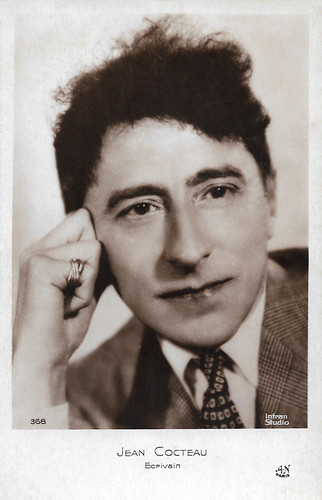
French postcard by A.N., Paris, no. 368. Photo: Intran Studio.
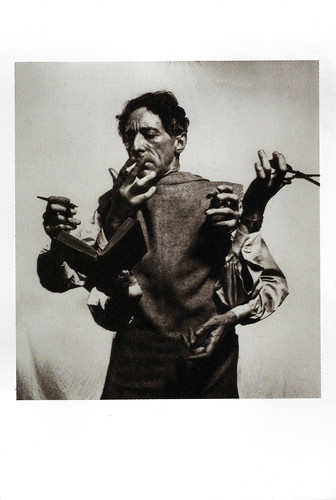
French postcard. Photo montage: Philippe Halsman / Magnum Photos. Caption: The French writer Jean Cocteau in a photographic montage by Philippe Halsman.
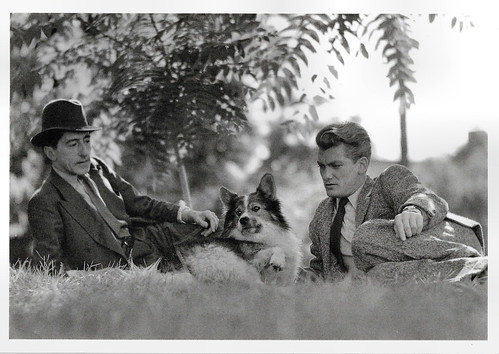
French postcard by Editions Hazan, Paris, in the Collection Magie Noire, no. 1960. Photo: unknown. Jean Cocteau and Jean Marais.
Openly homosexual
Jean Maurice Eugène Cocteau was born in 1889 in Maisons-Laffitte, Seine-et-Oise (now Yvelines), France. Cocteau was born into a middle-class family. Cocteau's father committed suicide when he was about 10 years old. In 1900, he entered a private school and was expelled in 1904. After his expulsion from school, Cocteau ran away to Marseilles where he lived in the red-light district under a false name. Police discovered him in Marseilles and returned him to his uncle's care. Jean began writing at 10 and was a published poet by age 16. From 1908, he was a frequent guest in artistic circles.
Cocteau associated himself with Edouard de Max, a reigning tragedian of the Paris stage at this time. De Max encouraged Cocteau to write and on 4 April 1908, he rented the Theatre Femina for the premiere of the young writer's poetry. In 1909, Cocteau met the Russian impresario Sergei Daighilev who ran the Ballets Russes. In 1911, he wrote the libretto for 'Le dieu bleu, a ballet by the Ballets Russes. In 1917 came 'Parade', an avant-garde ballet by Cocteau, for which Pablo Picasso, among others, designed the sets and costumes and Erik Satie composed the music. In Guillaume Apollinaire's programme booklet, to describe the ballet, the word surréaliste was used for the first time. The ballet was not a great success, but it did establish Cocteau's name in the avant-garde of Paris.
In 1920, Cocteau met the aspiring writer Raymond Radiguet, then aged 17. They collaborated extensively, socialised, and undertook many journeys and vacations together. Cocteau also got Radiguet exempted from military service. After Radiguet released 'Le Diable au corps', a largely autobiographical story of an adulterous relationship between a married woman and a younger man, a period of productivity followed for Cocteau. This stopped in 1923 when Radiguet died of typhoid fever. Cocteau became addicted to opium in the period that followed. During Cocteau's recovery from his opium addiction, the artist created some of his most important works including the stage play 'Orphee' and many long poems.
Cocteau was openly homosexual. He was the author of the mildly homoerotic and semi-autobiographical 'Le Livre blanc' (The White Book), published anonymously in 1928. He never repudiated its authorship and a later edition of the novel features his foreword and drawings. Frequently his work, either literary (Les enfants terribles), graphic (erotic drawings, book illustration, paintings) or cinematographic, is pervaded with homosexual undertones, homoerotic imagery/symbolism or camp.
In 1926, he published 'Le rappel à l'ordre', a book of essays describing the renewed interest in traditions in the post-World War I period. In 1929, Cocteau wrote his best-known work, 'Les Enfants terribles'. In the early 1930s, Cocteau wrote what some believe to be his greatest play, 'La Machine Infernal'. The play was a treatment of the Oedipus theme. Cocteau also wrote 'La voix humaine' (1930, The Human Voice), 'Les chevaliers de la table rounde' (1937, The Knights of the Round Table), 'Les parents terribles' (1938, Intimate Relations), and 'La machine a ecrire' (1941, The Typewriter).
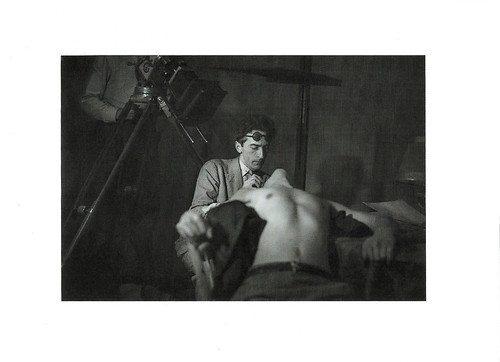
French postcard by Editions du Centre Pompidou, no. CP 2217. Photo: Sacha Masour. Jean Cocteau paints the eyes of Enrique Rivero at the set of Le Sang d'un poète/The Blood of a Poet (Jean Cocteau, 1930).

French card, no. C142. Photo: Aldo. Jean Marais and Josette Day in La belle et la bête/Beauty and the Beast (Jean Cocteau, René Clément, 1946).

Swiss postcard by CVB Publishers. Image: Collection Cinémathèque Lausanne. French poster for La Belle et la Bête (Jean Cocteau, René Clément, 1946). The poster was designed by Cocteau's friend Jean-Denis Malcles.

French postcard by Carterie artistique et cinématographique, Pont du Casse, no. EDC 2827. Affiche for Les enfants terribles/The Terrible Children (Jean-Pierre Melville, 1950), based on the play by Jean Cocteau.

Swiss / British / German postcard by News Productions, Baulmes & Stroud / Filmwelt Berlin, Bakede, no. 56482. Photo: Collection Cinémathèque Suisse, Lausanne. Jean Marais in Orphée/Orpheus (Jean Cocteau, 1950).
The Beauty and the Beast
Jean Cocteau's film debut Le sang d'un poète/The Blood of a Poet (1930) starring Enrique Rivero, was a grand experiment in an effort to capture a young poet's obsession with the struggle between the forces of life and death. He is condemned to walk the halls of the Hotel of Dramatic Follies for his crime of having brought a statue to life. Because of the October 1930 scandal around Luis Buñuel's L'âge d'or (1930) - another film financed by Le Vicomte de Noailles and Marie-Laure de Noailles, the Paris premiere of this film was delayed until January 1932. The film is the first part of Jean Cocteau's Orpheus Trilogy (1932-1960); a loosely connected telling and re-telling of the well-known Greek legend. During the next years, the artist's work lapsed. One reason for this is his recurring addiction to opium.
Wikipedia: "Although in 1938 Cocteau had compared Adolf Hitler to an evil demiurge who wished to perpetrate a Saint Bartholomew's Day massacre against Jews, his friend Arno Breker convinced him that Hitler was a pacifist and patron of the arts with France's best interests in mind. During the Nazi occupation of France, he was in a "round-table" of French and German intellectuals who met at the Georges V Hotel in Paris, including Cocteau, the writers Ernst Jünger, Paul Morand and Henry Millon de Montherlant, the publisher Gaston Gallimard and the Nazi legal scholar Carl Schmitt. In his diary, Cocteau accused France of disrespect towards Hitler and speculated on the Führer's sexuality. Cocteau effusively praised Breker's sculptures in an article entitled 'Salut à Breker' published in 1942. This piece caused him to be arraigned on charges of collaboration after the war, though he was cleared of any wrongdoing and had used his contacts in his failed attempt to save friends such as Max Jacob.
Jean Cocteau's return to work in the 1940s was primarily due to the influence of his protégé and lover Jean Marais, who starred in La belle et la bête/Beauty and the Beast (Jean Cocteau, 1946), based on the eponymous tale by Jeanne-Marie Leprince de Beaumont (1756). Marais played three roles, the Beast, Beauty's suitor, and the Prince, and Josette Day played Belle. The film marked a triumphant return of Cocteau to the screen.
Cocteau and Marais also made L'aigle à deux têtes/The Eagle with Two Heads (Jean Cocteau, 1948) and Les parents terribles/The Storm Within (Jean Cocteau, 1948). In Cocteau's most important film, Orphee/Orpheus (Jean Cocteau, 1950), Jean Marais is a poet who becomes obsessed with a Princess, Death (Maria Casares). They fall in love. Orphee's wife, Eurydice (Marie Déa), is killed by the Princess' henchmen and Orphee goes after her into the Underworld. Although they have become dangerously entangled, the Princess sends Orphee back out of the Underworld, to carry on his life with Eurydice.
In 1955, Cocteau became a member of the Académie française and he was also awarded the French Legion of Honour. In his final film, Le testament d'Orphée/Testament of Orpheus (Jean Cocteau, 1959), Cocteau himself played the poet Orpheus who looks back over his life and work, recalling his inspirations and obsessions. Cocteau made about twelve films in his career, all rich with symbolism and surreal imagery.
Jean Cocteau passed away in 1963 at his chateau in Milly-la-Foret, France at the age of 74. He died of a heart after hearing the news of the death of another friend, the singer Edith Piaf. Cocteau's chateau was bought by the government on the initiative of a committee that wants to keep his memory alive. It was inaugurated as a Cocteau museum in 2010. Cocteau's longest-lasting relationships were with French actors Jean Marais and Édouard Dermit, whom Cocteau formally adopted. According to his wishes, Cocteau is buried beneath the floor of the Chapelle Saint-Blaise des Simples in Milly-la-Forêt. The epitaph on his gravestone set on the floor of the chapel reads: "Je reste avec vous" (I stay with you).

American postcard by Fotofolio, NY, NY, no. MR 37. Photo: Man Ray, 1924.

Vintage French postcard. Collection d'Art et d'Histoire, Paris.

French postcard by Marion-Valentine, Paris, no. N 118. Photo: Germaine Krull / Collection Bibliothèque Nationale. Caption: Jean Cocteau, 1929.

French postcard in the Collection Magie Noire by Editions Hazan, Paris, no. 6037, 1988. Photo: Serge Lido. Caption: Édith Piaf and Jean Cocteau, 1939.

French postcard by Musée Carnavalet, Paris, no IC 40 2125. Photo: Pierre Jahan. Caption: Jean Cocteau in his window, 86, rue de Montparnasse, Palais Royal, Paris (1er arr.), 1941.
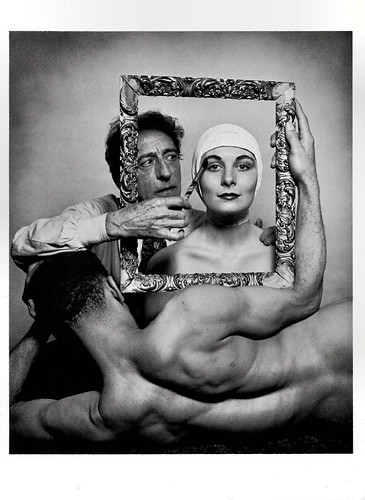
French postcard by Fotofolio, N.Y., N.Y, no. PH8. Photo: Philippe Halsman, 1949. Caption: The Act of Creation. Cocteau with actress Ricki Soma (wife of John Huston and mother of Anjelica) and dancer Leo Coleman.

Swiss / British / German postcard by News Productions, Baulmes & Stroud / Filmwelt Berlin, Bakede, no. 56514. Photo: Collection Cinémathèque Suisse, Lausanne. Maria Casarès in Orphée/Orpheus (Jean Cocteau, 1950).
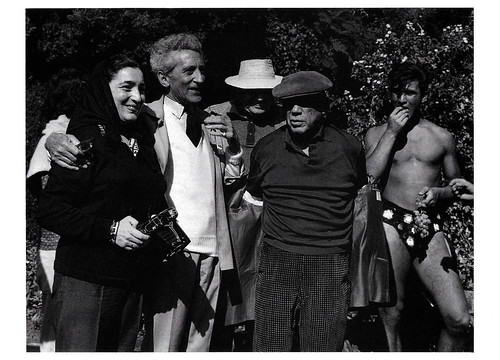
Swiss postcard by News Productions, Baulmes / Stroud / Filmwelt Berlin, Bakede, no. 56513. Photo: Collection Cinémathèque Suisse. Jean Cocteau and Pablo Picasso on the set of Le Testament d'Orphée/Testament of Orpheus (Jean Cocteau, 1960).

French postcard TTG / ADAGP, Paris, 2013, no. 0183000053. Photo: Lucien Clergue. Matador Luis Miguel Dominguin, Jacqueline and Pablo Picasso, Jean Cocteau, Lucia Bosé and Serge Lifar. Cocteau's final film, Le Testament d'Orphée/The Testament of Orpheus (1960), featured appearances by Picasso and Dominguín,
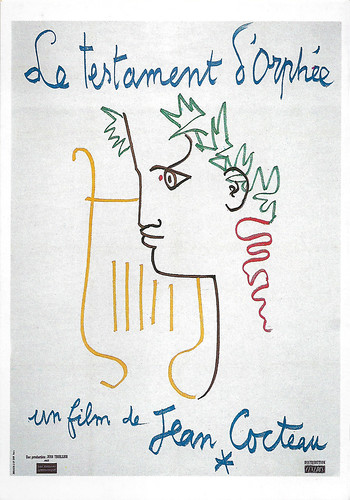
French postcard by Fernand Hazan, Paris, no. 1603 C. Poster design: Jean Cocteau. French poster for Le testament d'Orphée/Testament of Orpheus (Jean Cocteau, 1960).
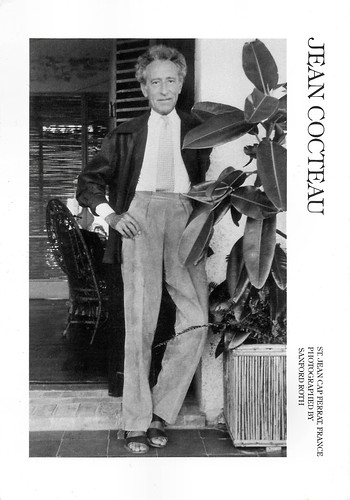
American postcard by Pomegranate, Corte Madera, Calif, no. 35-5135. Photo: Sanford Roth. Caption: Jean Cocteau, French dramatist, novelist, critic and poet. St. Jean, Cap Ferrat, France.
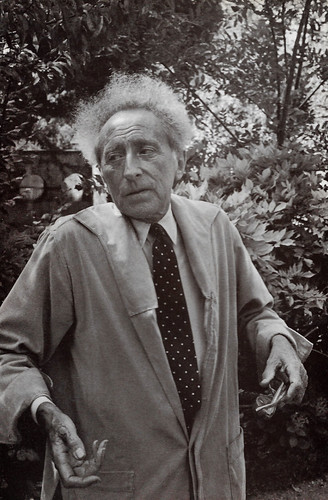
French postcard in the series Personnalités du XXe siècle by Opsis, Paris, no. C 4. Photo: J. Mounicq.
Sources: Alan Katz (IMDb), MFA - Masterworks Fine Art Gallery, Wikipedia (Dutch and English) and IMDb.
No comments:
Post a Comment